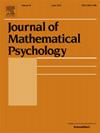关于抑制要素模型的数学形式化
IF 1.5
4区 心理学
Q2 MATHEMATICS, INTERDISCIPLINARY APPLICATIONS
引用次数: 0
摘要
抑制要素模型(Brandon et al., 2000; Wagner and Brandon, 2000)作为一种要素模型被提出来,它可以再现皮尔斯(1987, 1994)提出的构型模型,尽管最近索瓦特和拉赫尼特(2020)对其数学形式化进行了改进,但它是否真的再现了皮尔斯的模型仍是一个未决问题。在这项工作中,我将进一步发展抑制要素模型的数学形式化,将其纳入吉兰达(2015,2018)提出的形式主义中。在此过程中,我将推导出抑制元素模型重现 Pearce 模型的条件,表明当所有刺激都被假定具有相同的 "显著性 "时,只有当应用仅限于相互包含或没有共同元素的化合物时,这些模型才会重合。最后,我们将把在此基础上发展起来的数学形式化方法用于分析比较 "抑制元素模型"、雷斯科拉和瓦格纳的模型(雷斯科拉和瓦格纳,1972;瓦格纳和雷斯科拉,1972)以及皮尔斯模型在若干学习现象中的应用。本文章由计算机程序翻译,如有差异,请以英文原文为准。
On the mathematical formalization of the Inhibited Elements Model
The Inhibited Elements Model (Brandon et al., 2000; Wagner and Brandon, 2000) has been proposed as an elemental model that may reproduce the configural model proposed by Pearce (1987, 1994), and although its mathematical formalization has been recently improved by Thorwart and Lachnit (2020), whether it actually reproduces Pearce’s model has remained an open question. In this work I further develop the mathematical formalization of the Inhibited Elements Model by casting it within the formalism proposed by Ghirlanda (2015, 2018). In doing so I will derive the conditions under which the Inhibited Elements Model reproduces Pearce’s model, showing that when all stimuli are assumed of the same “salience” these models coincide only when the application is restricted to compounds that either contain each other or have no common elements. Finally, the mathematical formalization developed here will be applied to the analytic comparison of the Inhibited Elements Model, Rescorla and Wagner’s model (Rescorla and Wagner, 1972; Wagner and Rescorla, 1972), and Pearce’s model in the context of several learning phenomena.
求助全文
通过发布文献求助,成功后即可免费获取论文全文。
去求助
来源期刊

Journal of Mathematical Psychology
医学-数学跨学科应用
CiteScore
3.70
自引率
11.10%
发文量
37
审稿时长
20.2 weeks
期刊介绍:
The Journal of Mathematical Psychology includes articles, monographs and reviews, notes and commentaries, and book reviews in all areas of mathematical psychology. Empirical and theoretical contributions are equally welcome.
Areas of special interest include, but are not limited to, fundamental measurement and psychological process models, such as those based upon neural network or information processing concepts. A partial listing of substantive areas covered include sensation and perception, psychophysics, learning and memory, problem solving, judgment and decision-making, and motivation.
The Journal of Mathematical Psychology is affiliated with the Society for Mathematical Psychology.
Research Areas include:
• Models for sensation and perception, learning, memory and thinking
• Fundamental measurement and scaling
• Decision making
• Neural modeling and networks
• Psychophysics and signal detection
• Neuropsychological theories
• Psycholinguistics
• Motivational dynamics
• Animal behavior
• Psychometric theory
 求助内容:
求助内容: 应助结果提醒方式:
应助结果提醒方式:


